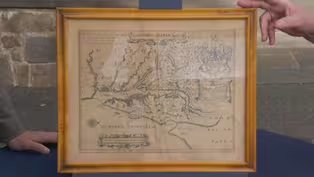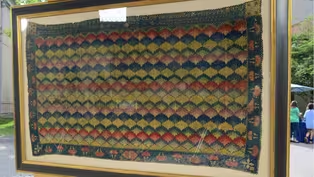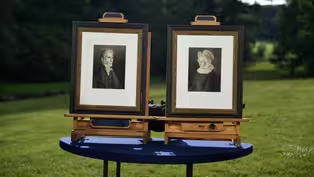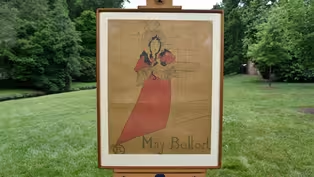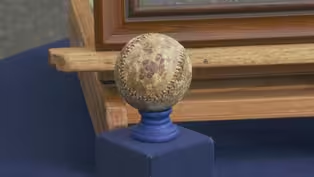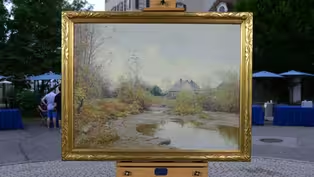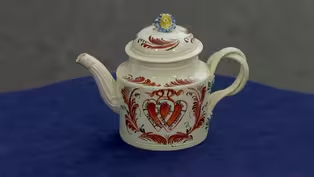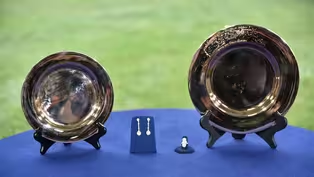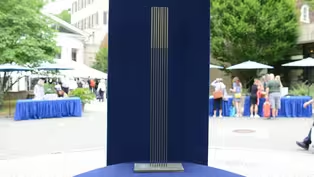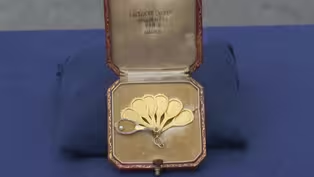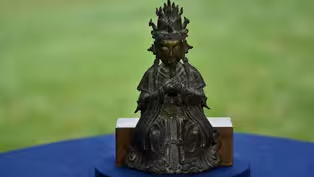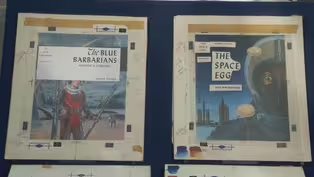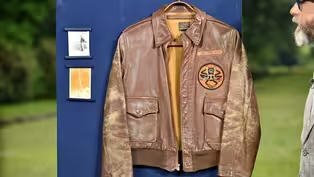

Winterthur Museum, Garden & Library, Hour 3
Season 24 Episode 3 | 52m 28sVideo has Closed Captions
Wrap up ROADSHOW’s first-ever visit to Delaware with an $80K-$150K appraisal and more!
Wrap up ANTIQUES ROADSHOW’s first-ever visit to Delaware with incredible appraisals including 1820 J.J. Audubon portraits, a Ming Dynasty Xiwangmu figure, and Ric Binkley science fiction illustrations, ca. 1950. Learn which is $80,000-$150,000!
Problems playing video? | Closed Captioning Feedback
Problems playing video? | Closed Captioning Feedback
Funding for ANTIQUES ROADSHOW is provided by Ancestry and American Cruise Lines. Additional funding is provided by public television viewers.

Winterthur Museum, Garden & Library, Hour 3
Season 24 Episode 3 | 52m 28sVideo has Closed Captions
Wrap up ANTIQUES ROADSHOW’s first-ever visit to Delaware with incredible appraisals including 1820 J.J. Audubon portraits, a Ming Dynasty Xiwangmu figure, and Ric Binkley science fiction illustrations, ca. 1950. Learn which is $80,000-$150,000!
Problems playing video? | Closed Captioning Feedback
How to Watch Antiques Roadshow
Antiques Roadshow is available to stream on pbs.org and the free PBS App, available on iPhone, Apple TV, Android TV, Android smartphones, Amazon Fire TV, Amazon Fire Tablet, Roku, Samsung Smart TV, and Vizio.
Buy Now
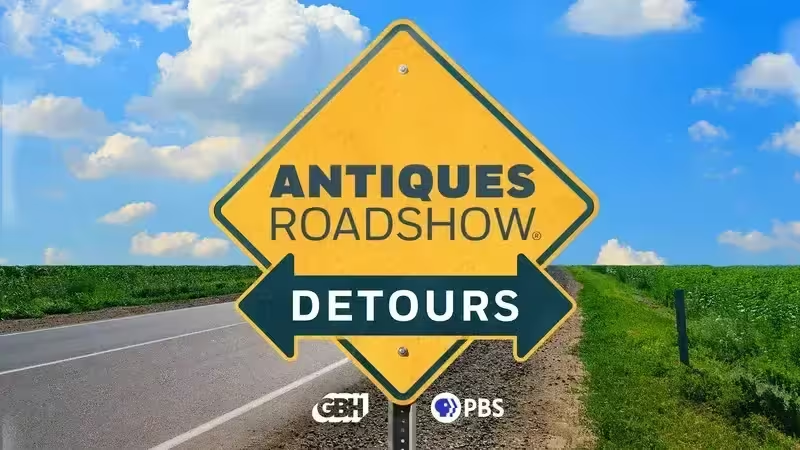
ANTIQUES ROADSHOW DETOURS
Ever wondered what happens to the treasures featured on America’s beloved ANTIQUES ROADSHOW after the cameras leave town? Host Adam Monahan tracks down the juicy afterlives of your favorite finds from PBS’s hit series.Providing Support for PBS.org
Learn Moreabout PBS online sponsorship♪ ♪ CORAL PEÑA: "Antiques Roadshow" is finding surprising antiques and even more surprised collectors at Winterthur Museum, Garden, and Library.
Your grandfather can be in the same sentence as Babe Ruth.
Almost getting choked up.
It's pretty exciting.
♪ ♪ PEÑA: "Antiques Roadshow" is set up and ready for the curious guests all around Winterthur Museum.
Its founder, Henry Francis du Pont, was an inspired horticulturalist and an insatiable collector of American decorative arts and antiques.
To fill the 175 period rooms of his now-96,000-square-foot home-turned-museum, du Pont bought thousands of items every year.
Du Pont was particularly enthralled with the treasures that had a patriotic connection, like this unfinished painting begun in 1783 by Benjamin West, holding a place of honor in the dining room; and below it, the only known set of six silver tankards by Paul Revere.
Roadshow guests are proud to show off the items they've brought today.
Take a look.
♪ ♪ ...stay together.
Okay.
♪ ♪ The interesting thing is, I came with my, my former boyfriend.
This is my present boyfriend's clock.
Really?
This guy keeps it going.
They call it the jumper.
The jumper number one.
These things obviously were, were... they didn't survive.
I mean, these things were just kind of used, read, and thrown away, like a newspaper, I mean.
But in this condition, I'd say, just by itself, this one thing would be $500 to $700.
Is that correct?
Yeah.
I didn't, I think I might have paid $35 for it... Yeah, it's definitely, I mean, because usually, like I said, we see them in really terrible condition.
My hair is really flat this morning.
Yeah, no, it looks good.
Thank you.
I know I kept... WOMAN: I brought this sculpture.
It's sort of like a wind chime, it makes noise.
It was from my parents.
When my father died, it was always at their house.
And then, after my mother died many years later, my brothers and I divided things up.
APPRAISER: Mm-hmm.
And my mother always thought that my dad had made it.
And when it was time to divide things up, my brothers weren't interested, and I, being an art teacher, I was interested.
And so, I got it.
And then one year, I saw something similar on "Antiques Roadshow," and I wrote down the name and I looked him up on the internet and... My cousin and I applied for these tickets, thinking that if I got here, I would bring the sculpture.
(laughs) I had it on my porch, and my dogs, their tail would hit it, and it would make noise.
And my cousin kept saying, "You have it on the porch?
You better get it off the porch."
And finally I said, "It's off the porch."
(chuckles) The artist is Harry Bertoia, and he was actually an Italian artist that came to the U.S. in 1930.
He was born in 1915, so he was just a teenager.
Oh.
And he came to Detroit and was awarded a scholarship to the Cranbrook Academy of Art.
He eventually moved to Barto, Pennsylvania.
He opened a big studio there in a barn, and he also took a job designing chairs for Florence Knoll.
So, he was originally really known as a furniture designer.
That's how he kind of made a living.
Oh.
And that's what people first recognized him for.
However, over time, it's really his sculptures that have become quite important, and that's what he's best known for.
This is made of beryllium copper.
It's most likely from the mid-1960s, which is when he was doing this type of work.
And this is from his "Sonambient" series.
He did make a lot in this series, we don't know the exact number.
I would guess somewhere in the high hundreds to low thousands.
They all vary.
Some of them are much shorter.
There are some taller, different configurations.
There's kind of three components that are really interesting.
It's first and foremost a visual work of art.
It's visually stunning, it's very exact and precise.
Mm-hmm.
Which is what Bertoia was all about.
This form-- which he did over and over again, of these beryllium rods-- really took inspiration from the wheat fields that he experienced... Oh, ah.
...when he was a boy in Italy.
Many of them are just the straight rods.
This actually has the wider rod at the top.
Yes.
They're often called cattails.
That's what I thought, cattails.
And that actually makes this quite desirable.
But it's also a kinetic sculpture.
Yes.
Because it moves, and in that way, it also relates to the wheat, as if it were sort of swaying.
Just a little breeze can hit it, and it will start to move, which is quite lovely.
Yeah.
And finally, it's also a sound sculpture.
And so, when you strike the work, or you move your fingers across the rods, it makes a noise.
Hmm.
He began to make recordings of these sculptures.
Oh, my gosh.
Yeah, and actually, just in 2016, the Bertoia estate reissued an album that he made of these recordings.
So, this piece is not signed.
Most of his sculptures were not signed.
He believed that the art was the signature itself.
And it certainly is in this case.
This is classic Bertoia, you can't mistake it for anything else.
And we see all the components are exactly as he made them in these sculptures.
He felt that his art was part of the universe, and that's really what was important.
And he didn't want to put his name on it and make it about himself.
If you just run your hands across it, it makes a lovely sound.
(rods chiming) Well, this-size work, a 'Sonambient" sculpture by Harry Bertoia, at auction, we would estimate this today at $20,000 to $30,000.
Wow, pretty good.
Almost getting choked up.
That's pretty exciting.
Those kind of heavier rods on the top keep it moving a little longer and make a sound that's a bit louder.
Well, this is a powder horn that has been in my family for about as long as we can remember.
Okay.
And it says it's from January 7, 1757.
We looked at the name, and it's Noah Yeager.
Okay, we had... 1757.
I think we had some Yeagers in our family.
I would put an estimate on it at auction of $2,000 to $4,000.
That's great.
Yeah.
So my great-grandfather worked for the University of Delaware and went to Afghanistan for three years.
And he played in a band, and he brought this back.
He played sitar in a band in Afghanistan.
Oh, really?
Yeah.
Nice.
Uh-huh.
How long ago was that?
In the '60s, early '60s.
It's a sitar-type instrument.
Type, okay.
It's more of a tourist-type of an instrument.
Okay.
Not really meant to be played.
WOMAN: I bought it at an antique show in Fort Washington, Pennsylvania, probably about 15 years ago.
APPRAISER: Okay.
When my husband and I go out antiquing, which he can't do anymore, he would go one way, and I would go the other way.
And we usually would meet at a certain time.
But I get called on the loudspeaker... "Maggie... report to, report to, report to..." And I'm thinking, "Oh, my gosh, did he fall into a case and break something or what?"
Oh, oh.
And then I see him down the aisle, and he's, "Come on, come on, come on, come on!"
I knew, I knew he found something really precious.
Oh, how fabulous.
But unfortunately, when he does that, I don't get the bargain anymore.
Oh, true-- he's in love with it, then.
Well, and they know that they have an, an honest sale.
I wear it closed.
And then I say, "Well, just a minute."
I flip the little notch on it, and it flies open.
Can you show me how to do it?
Yes, yes.
And then we hear a big, "Wow!"
(both laughing) I'll just put my hand down here and go like this... whoop!
That really flips open.
This is interesting, not just because it's such a charming locket, when there's actually one, two, three, four, five, six places for photographs.
Yes.
It's by a company called Lacloche Frères.
They were Spanish brothers that moved to Paris at the beginning part of the 20th century and became purveyors and makers of very fine jewelry.
It's made of 18-karat gold.
Wow.
Rose-cut diamonds.
There's a small ruby here.
Mm-hmm.
At the hinge.
And then a tiny seed-pearl tennis ball.
The piece is marked on the reverse there by the maker, "Lacloche."
And then there's also a patent number for the mechanism of the locket itself.
It's in its original box, which is fabulous.
Do you have a memory of what you paid for the piece?
Yes.
(chuckles): A lot.
Okay.
And what was that number?
$4,000.
Okay, in a retail market today, this would likely retail somewhere in the neighborhood of $10,000.
Wow.
If not more.
Uh-huh.
So you did very well.
(laughs): Thank you very much, that's wonderful.
They say to buy what you love, yes.
And I love wearing it.
PEÑA: This Argand lamp, named after a Swiss inventor, was bought by founding father Thomas Jefferson for Charles Thomson, secretary of the Continental Congress.
Made in England in the 1780s, these types of lamps produced up to ten times the light of earlier oil lamps and burned longer, allowing people to do significant work after sunset for the first time.
MAN: This poster came into our family in the 1960s.
My grandfather went to London for work.
We did find some documentation indicating that this is where the poster was bought.
My grandmother was not a cat lover.
So, the family lore goes, my grandmother did not want it displayed.
We believe it, it ended up maybe in a closet, kind of out of official view, probably for several decades.
I've been involved with the Antiques Roadshow for over two decades.
I say it because in that entire time period, we have not had a poster by Toulouse-Lautrec on the show.
So, this is a first.
And it's very exciting to be able, finally, to, to bring to camera something by the work of an artist who was so pivotal in the poster market.
In 1891, he was the first serious artist who applied his craft to the brand-new field of commercial lithography, and he designed posters mostly for his friends who were musical performers.
I see.
His friends included Aristide Bruant, his friends included Jane Avril-- these giants of the French music hall stage.
And then there's this work for May Belfort, who was not a particularly famous performer.
In fact, May Belfort wasn't even her original name.
It's her stage name.
She was an Irishwoman whose name was May Egan.
I see.
And she came to Paris through the music halls of London.
And her performance consisted of her onstage holding a cat and sort of purring a little bit incoherently, but telling double-entendre jokes and delivering slightly saucy lines while holding her cat.
(chuckling) Apparently, her most famous line was, "I have a little cat, I'm very fond of that."
That's the kind of... that was the basis of her show.
Now, Toulouse-Lautrec was a denizen of the Parisian demimonde, the, the nightlife of Montmartre.
He would go to these music halls.
And the story has it that when he saw her perform, specifically, when he heard her cite this inane little line, he immediately fell in love with her.
Okay.
And he was so smitten with her and so smitten with the inanity of her act, that he decided to design a poster for her, which would have been a huge deal for this little-known performer to have a giant artist, the size of Toulouse-Lautrec, design the poster.
Sure.
It's kind of ironic, he was a very small man.
Sure.
But he was a giant in the art world.
And by all accounts, it's this very sort of tender and humane handling of her which a lot of art critics have said over the years shows how much he really cared for her.
It's an incredibly, deceptively simple design.
There's four colors-- there's red, there's green, there's black, and there's yellow.
You can see a little bit of yellow in her hair and in the cat's ribbon.
Mmm.
He's created the idea of her being onstage with this very simple diagonal line.
He's very basically represented the background of the stage behind her, but he really focuses on her face.
This is Toulouse-Lautrec's signature right here.
You can see-- his name was Henri de Toulouse-Lautrec, so you see an H, a T, and an L in his monogram.
Okay.
It's an original lithograph, so it's not one of a kind.
Several hundred, if not 1,000 of them, were printed.
We actually don't know the exact number, because nobody kept track.
It was done in 1895.
It's not in great condition.
The Toulouse-Lautrec market is a fascinating market, and he's, he's a famous poster artist.
He's a national hero in France.
He's a great painter.
He's renowned for so many different things.
The first poster he designed for the Moulin Rouge, his, his explosion onto the poster scene, is a half-million-dollar poster.
But one of the things that really drives the value of Toulouse-Lautrec posters is the condition.
Given that this piece is not in great condition, I would say that currently, at auction, I would estimate it between $4,000 and $6,000.
Okay, well, that's very nice.
No, that's perfect.
We're going to keep it.
I would say, also, that if you were to put maybe $1,000 into restoring it, in better condition at auction, it would fetch between $8,000 and $12,000.
Wonderful.
At its peak in 2007, in very fine condition, it sold for $40,000.
Oh, nice.
I purchased it at an auction one time with other train stuff, and don't know any real history on it, but want to know, is it real or is it a fake?
(chuckles): Do I buy it or don't I... Am I putting $75 down a rat hole or not?
He got it as a birthday gift, back in, when they first came out in the '50s.
Okay.
And this was the Hamilton Electric.
And this is the best version, because it's 14-karat gold.
Right.
APPRAISER: So, what do you have here?
A camera that I got from my Uncle Eddie after he passed away.
I probably have it 30, 40 years.
Mm-hmm, it's an early-20th-century Graflex press camera.
As you can see, it says "Speed Graphic" on the front.
And it's great, because you can swap out the lenses very easily.
And it's got an accessory flash.
Wonderful colors, in wonderful condition.
But to be absolutely honest, no one cares about the camera.
Okay.
They care about the flash.
Okay.
This flash handle... is something special.
What does this look like to you?
Oh, I thought it was a tripod or something.
What if I make... (making buzzing sound): ...sounds?
Oh, light sabers?
Exactly.
(laughing) So when they...
I don't do "Star Wars."
Oh!
Sorry.
Now you're breaking my heart.
So, when they were doing the props for "Star Wars" in 1977, the prop master found a box full of Graflex flash handles and actually made this into the prop that Obi-Wan found in the chest, took out... Oh, my God.
...and gave to Luke Skywalker.
These are very collectible amongst aficionados and fans of "Star Wars."
The camera's a $200, maybe $300 camera.
Okay.
What do you think the flash handle's worth?
$1,000.
Darn close.
Oh.
(chuckles) You're probably looking around $600 to $800 at auction.
Okay.
So, it's not going to pay the kids' education.
No, but it'll fuel their dreams.
(laughing) Thank you so much.
Thank you so much, really appreciate it.
Surprise!
That's for sure!
(laughing) PEÑA: Earlier, we mentioned this post-American Revolution painting by Benjamin West, "American Commissioners of the Preliminary Peace Negotiations with Great Britain."
The unfinished image depicts American dignitaries John Jay, John Adams, Benjamin Franklin, Henry Laurens, and secretary William Temple Franklin.
Who's missing?
Two British diplomats, Richard Oswald and Caleb Whitefoord.
Oswald refused to sit for the portrait, and the artist was unable to complete the work.
I'm a junker, and I found this at an auction, and I bought it.
Probably '98, '97.
You paid how much for it?
About $90.
One of the first things that one does is identify the material.
It's bronze.
Is it from a mold that then was personalized?
It would have been cast, it would have been cast.
It was a cast?
And then finished, chased, by hand.
Right.
And as we go to the other side, we'll see that in fact, this was quite resplendent at one time, because you can see... Oh, the gilding.
...the remnants of gilding on the back.
This does rub off, and you would have people who were devotees who would come and... And touch her?
And touch it.
Oh, okay.
Touch the figure.
What happens over a period of hundreds of years is, that gold, which is very, very thin...
Wears off.
Wears away.
And you'll notice one place that it hasn't worn away is the face.
Ah.
Because you don't touch people's faces.
You don't touch the face.
The other aspect of this-- it's a clue to what the figure is-- is this, the tablet.
It's a form called a hu.
So, if you were going back to China... Uh-huh.
And this is Chinese.
It is Chinese, okay.
And you were trying to have a petition to a regional authority...
Okay.
...or even to the emperor, you would go with a tablet on which would be written issues that were of concern to you that you wanted to petition that authority with.
Wow.
And it was kind of a formal type of presentation.
But it also rose beyond this earthly realm, and it would go to a higher authority.
Huh.
Which is the Queen Mother of the West, Xiwangmu.
Wow.
And so this would be in someone's Taoist temple setting.
Okay.
It's a Taoist figure.
So, this is a, a rarer example, dating probably somewhere between the 16th, 17th century.
Wow!
I wasn't going to say, "Wow."
Um... (laughing) Why was there wax underneath it?
Well, that's something we're going to share.
And that's also a puzzle, because someone put wax with a candle wick in the base.
And the only thing I can think is, this was not a good idea.
(laughs) It provides no support for the metal.
No.
Which is quite strong.
Right.
And I don't think it's damaged the figure at all, because it is wax, and I think it's going to come out.
I wouldn't remove it.
Yeah.
Not something that we advise anyone to do.
What do you think this would be worth today?
Maybe $500?
I think it's more likely $4,000 to $6,000 at auction.
Oh, really?
Oh, ooh!
It's from the Virgin Islands, or we, we acquired it in the Virgin Islands.
Okay.
Clients of ours moved there from California about 15 years ago.
This is a Beijing opera costume for the lead actor, who would play Guan Yu.
My mother bought this in Albuquerque, New Mexico, in an antiques store.
She was very interested in antiques and had a little bit of knowledge about them, but had a very special relationship to this particular piece.
And I... so, I'm very curious about it.
MAN: Mary Betty Binkley lived next to my family growing up, and she was the sister of the artist Ric Binkley.
We took care of her as, as she continued to get old, and, and then, as she was moving into a nursing home, she said to my mom, "I'm not sure what to do with these.
I guess you, you could just throw them away."
My mom said, "There's not a chance we're going to do that.
They're just way too beautiful."
And so Mary Betty gave them to my mom to give to me.
Well, in illustration art, there are so many different niches.
There's pin-up art.
Mm-hmm.
There's children's book illustration.
But sci-fi is really a big area lately.
Okay.
And there's been a resurgence in the interest in this.
You have some that already have the book covers on them, identifying the name of the book, who the author was.
And then what I like about these is that they're all Avalon, which is the primary publishing house that he worked for.
Because he died early, he's one of the lesser-known illustrators, but that doesn't make him any less wonderful in the work of art.
Um, what, um, is so interesting in this particular market is that 50% of the value is the artist and 50% of the value is the author.
Okay.
So if these weren't sort of B paperbacks, um...
Right.
If it was Arthur Clarke or Isaac Asimov, that would add also to the value of the works.
I see.
So the ones that are easily identified to a particular paperback cover, those in his range would be between $2,000 and $3,000 at auction.
Wow, wow.
Now, these, if we can identify them to a certain book... Uh-huh, right.
They'd be the same value.
Wow.
If, of course, you can't, and they're just illustrations in the marketplace...
Right.
...they're going to be about half the cost.
I see, wow.
These are extraordinarily collectible.
Thank you so much for saving them.
Thank you so much.
I appreciate it.
WOMAN: It was in my grandfather's home up until he passed away in 1983 in Buffalo, New York.
That's when I inherited the picture.
He loved the Arts and Crafts movement, with the Roycroft group that was in East Aurora and was involved with them and interested in them, and ultimately purchased the picture.
And the artist is?
Alexis Fournier.
From what I can find out on, on the internet, he was involved in the Arts and Crafts movement and loved to paint landscapes, and was in Buffalo and also in Indiana.
The letter that accompanies the picture tells me it was painted in Indiana.
He was a very colorful character.
He was born in 1865 in Minnesota and he died in 1948.
Grew up between Minnesota and Wisconsin and basically lived in Minneapolis for quite a few years.
Became an artist, traveled kind of, well, quite widely for artistic training.
Like so many American artists, he traveled to Paris and studied at the Académie Julian in Paris, as well as becoming a great devotee of the Barbizon school and the Barbizon painters, the most famous of whom is probably Jean-François Millet.
Their veneration of nature, their kind of romanticized view of nature, made a huge impression on him, and he became a part of an American Barbizon movement when he came back, He was quite successful as a painter, and he became interested in the Arts and Crafts movement and the Roycroft Association, which was in and around Buffalo and East Aurora, New York.
Mm-hmm.
He became the sort of resident painter of the Roycrofter group.
You have here on your painting an example of a wonderful Arts and Crafts frame, which is, I believe, an original frame to the painting.
So, it enhances this package and this Arts and Crafts connection.
There's a small patch on the back that says my grandfather paid $500 for it.
And it's also inscribed on the reverse by the artist with the title, which I believe is, "An October Rain"?
"After an..." "After an October Rain."
Right.
Do you have any idea what it might be worth?
I don't.
I looked online, and it seems to me that paintings of his this size range between $4,000 and $6,000.
That is true of the average painting.
Okay.
Which this is definitely not.
And one of the things that makes this worth more is that very specific Brown County location.
Okay.
Because it will have a tremendous appeal to, particularly, Indiana collectors.
An auction estimate on this picture today might be in the $25,000 to $35,000 range.
Oh, that's... wonderful.
That's really, really good news.
I'm, makes me honored to have it and honored that my grandfather took such good care of it, and I do the same.
Thank you.
Well, and I would suggest an insurance value at the high end of that or maybe a little more, maybe as much as 40.
Wow.
Thank you.
Oh, thank you.
That's, that's wonderful.
I swore I wasn't going to cry.
I'm, like, stunned.
(sighs): That's wonderful.
I brought in a sword and scabbard that I rescued from my grandfather's attic.
This is patterned after a Model 1840 enlisted man's cavalry saber.
But what's neat about it, this is a Confederate-made 1840-pattern cavalry saber.
You can see the hand-hammer marks on the blade.
That's where this blade was hand-forged at the Confederate arsenal.
This is a sword, in a retail situation, would sell for about $1,200 these days.
Oh, nice.
If it was that U.S. 1840 in the same shape, you'd be looking about $350.
Oh.
So it makes a lot of difference being Southern.
APPRAISER: When you unwrapped this from a, a layer of two quilts, I was astonished.
Do you know why?
No, I don't.
(laughs): Okay.
I'd like to hear from you what you know about this.
Well, this is a, a tablecloth, I believe, they call it.
It was made in, in 1761 by a relative of mine, a Dutch young woman who lived in Millstone, New Jersey, which is north of New Brunswick.
My mother inherited it.
When she inherited it, it was rolled up into a brown piece of paper, it was rolled onto a cardboard roll, and it remained in our living room closet for, I would imagine, almost 20 years before I inherited it.
This is a flame-stitch tablecloth, which must have taken many, many hours to accomplish.
There is an inscription on the top of it that says, "This tablecloth was made by Elisabeth van Deursen in 1761."
There's another inscription that says, "How vain are all these worldly pleasures, "created beauty cannot last.
"Time diminishes at leisure what human hands have formed and cast."
So, it's kind of a heavy inscription.
(chuckles) But it is a beautiful piece of handwork.
And it is, unfortunately, beginning to fade away, but we can still have the pleasure of seeing it.
I can tell you, I've never seen a, a needlework tablecloth myself, personally.
In my experience, they're very rare, and one would expect that to be the case, because they received a lot of wear and tear-- they're on top of a table.
Yeah.
So, things could have been spilled on them just through use.
I think a lot of them have vanished into obscurity.
In this particular instance, Elisabeth learned her lessons well, because the expertise shown in this is very consistent.
I mean, this is a typical of a center-panel, flame-stitch pattern, which is seen in both English and American needlework, and I think these were made in England and America.
But, but the specific history surrounding this piece points to America, which is very exciting.
So, this flame-stitch panel is composed of this repeated design.
All the colors in this are derived from nature-- vegetable dyes-- so, as a result, they're very fugitive.
So you said that it's fading.
There's so much life left in this.
And the thing that struck me very quickly was just how bright and beautiful it still is.
It's not complicated, but very effective as a result.
And I believe this border that we see around it are stylized...
I believe they're supposed to be carnation blossoms.
That often appears in early English and American needlework.
There are a couple of areas in the piece which were darned by somebody.
Does anybody darn anymore?
I don't know.
So, in my estimation, it's one of the great American rarities, as far as needlework is concerned, that has somehow survived in miraculously good condition.
So, at auction I would estimate its value between $30,000 and $50,000.
It's very special.
Gracious.
And we're, we're at Winterthur, so I can say in the premises that this is definitely of museum quality.
There's no doubt about it.
Gracious!
Well, my wife and I have sometimes been disappointed that our daughter hasn't learned to appreciate antiques as much as we do.
But this appraisal will, I think, help her with her appreciation.
It, it should help.
PEÑA: This captivating needlework was acquired by H.F. Du Pont in 1966.
The silk-on-silk creation was executed by Mary King of Philadelphia in 1754.
King's "Tree of Life" pattern was likely inspired by textiles imported from India that featured this popular design.
No, it was in our living room growing up, and, um, I'm a fan of Manet, but I don't know anything about the piece, so...
This is like a paper mâché with little composition hands.
Okay.
Yeah, these are truly mass-produced.
They are mass-produced.
Yeah.
So, just a partial set like this, you're, you're probably talking about $20 each.
Well, my grandfather started in, out of college, 1902, he got picked up by the Baltimore Orioles.
Mm-hmm.
He played there for one year.
Then he moved out to Minneapolis and played for the Millers for seven or eight years.
Right.
And in 1903, he hit this ball to be the shortest home run in history to date.
My grandfather is small.
His batting stance, he was hunched up, he was hard to pitch to.
And apparently, it was a wild pitch, and it hit the back of his bat and shot straight down into the mud.
It had just rained.
This was the last out of the game.
It shot straight down in the mud, about two feet in front of home plate.
Right.
Nobody saw it, I think everybody must have looked up.
He ran around the bases, touched home plate, and pulled the ball out of the mud.
And, and it was, it's nicknamed the Mud Ball.
And then he took the ball, and he, he addressed it.
You can see, there's just a little bit...
Right here?
That's... That's the postage stamp.
Mm-hmm.
He addressed it, put a postage stamp on it, and mailed it back to my grandmother.
And then he followed it with a letter explaining what it was.
You have a letter?
We have a letter.
I don't have it on me, but there is a letter.
And it's been rolling around in a desk drawer for 100 years, I guess.
(laughing) So, first of all, you can see that this is very muddy.
It is.
He must have...
I'm hoping he let it dry out a little bit before he sent it to your grandmother.
I would hope so, I would hope so.
But it's still pretty cruddy.
Do you know what, who had the longest home run ever in baseball history?
No, I do not.
Babe Ruth, 1921.
Is that right?
How about that?
Babe Ruth.
So, your grandfather can be in the same sentence as Babe Ruth.
There you go.
The longest home run.
The shortest home run.
The shortest home run.
Correct.
I love this ball, and I love this story, 'cause I had never heard it before until you brought this ball.
I'm not aware of any home run that probably comes close to this.
Nor am I, yup.
At 24 inches.
And I noticed it's been documented in, in a couple of different books.
It has.
There are a couple of historians that may be a little bit skeptical, but my feeling is they might change their mind, knowing now that this ball exists, and a letter.
I hope so, yeah.
So, look, now we get to the valuation part of it.
Okay.
And there have been items that have been associated with crazy or iconic or odd moments, incredulous moments in baseball history.
I'm looking at the photo as-- and the cap that he wore with the Millers and the baseball-- and I got to tell you, I know it was a minor-league team, but because this is such a crazy situation, I'd put $3,000 to $5,000 on the ball.
Wow, that's great.
I mean, are you ever going to have a, a shorter home run?
That's right.
(laughing) Probably never, probably never.
That's great.
So, you know, I got to tell you, in this case, I think there will be joy in Mudville.
Yes, absolutely, that's right.
(laughs) MAN: These dishes were passed down to me from my grandparents.
They were given to my grandparents by Edwin Speidel, who was a jeweler in Providence.
My grandfather was a surgeon, and I assume that my grandfather must have operated on one of the Speidels, but I don't actually know the details of that.
But they were, then, lifelong friends.
The plates were given to them over a number of years.
There are ten of this smaller size, and then this larger one.
This one was presented in 1959, the larger one, because it's dated.
The other ones, I don't know.
I was told that they were given once a year.
The inscription, beautiful hand engraving, talks about the presentation to your grandparents.
Speidel was pivotal in making the expandable watch bracelets that became very popular.
He started with ten dollars in his basement with his wife in the later part of the 1800s in Germany.
Hmm.
But the connection to your family comes with Edwin, who was one of three sons who he sent over in 1904 to America.
They stayed in the family business, where they manufactured chains and costume jewelry.
Then, in the later 1950s, they redesign the expandable bracelet and it becomes what everybody knows as the Twist-O-Flex.
But let's go back to the dishes.
The small one, you said there's a little dispute in the family as to what they're made out of.
So, they're labeled 14-karat gold.
The family lore says that they're actually 24-karat gold, and that this was done for excise tax reasons.
But nobody has ever verified that fact.
I verified it today, when you weren't looking.
Okay.
(both laughing) They are marked "14-karat," and they are, in fact, 14-karat yellow gold.
The first plate weighs 400 pennyweights.
That translates to 20 ounces of gold in one plate.
Hmm.
You got ten of them.
Mm-hmm.
All right?
The larger plate weighs 600 pennyweights.
That's 32 ounces of gold.
That's a lot of gold.
Mm-hmm.
Now, let's talk about the jewelry.
Same family?
Same family.
I believe that this jewelry came from my great-grandparents, and he was a brewer in Munich and owned one of the big Munich breweries.
Then it was passed to my aunt.
I know that my aunt actually went back to Germany in the late 1930s, even being Jewish, and smuggled out a lot of jewelry.
I thought that this was some of that jewelry, but, of course, I don't know.
Both pieces of jewelry, the ring and the earrings, were most likely made in the early part of the 20th century.
The ring, especially, where you have this yellow gold on the bottom and the platinum on top, it's very indicative of jewelry made in the early 1915- 1920 period.
You have this wonderful gallery work.
Of course, you got two rather large diamonds.
They look like they're just under three carats each.
They're what we call old European cuts.
The other two stones in the middle are about half a carat each.
And then you have a wonderful, wonderful mounting.
And then you have these beautiful pendant or dropped earrings, maybe 1920, 1925.
Now, the diamonds in the earrings are not as good as the diamonds in the ring, but that was very common.
Because, a ring you could see, you'd be looking at it.
Earrings...
Right.
You didn't have to use stones as clean.
You could get away with it.
Those stones are easily over three carats each.
The ring we did have appraised about five years ago.
I believe it was around $40,000.
Okay.
But I don't recall exactly.
Just this plate over here and this plate here, if you combine them together, you're looking, just in gold, $40,000.
Mmm.
If the other plates were on the table, it's $180,000 just in gold.
This is something we deal with today.
Will somebody pay more than gold for something like this?
I don't know if the Speidel name will bring that to all the plates, but it might bring a premium to just this plate, for somebody who's a collector.
Mm-hmm.
Though I get the feeling it's never leaving the family.
No.
(chuckling) The ring, so, at auction today, it would probably be $20,000 to $30,000 that it would go in the catalogue.
But I got news for you-- for insurance purposes, it's no longer $40,000-- it's probably closer to $60,000 or $70,000.
Hmm, wow.
That's a big difference there.
The earrings, at auction, $15,000 to $20,000.
But those would be $40,000 in a retail setting.
Hmm, wow.
There's a lot on the table here.
Dare I say, very dishy.
(laughing) MAN: These are some of a collection of comics I had as a child.
APPRAISER: Yup.
That I bought when they came out.
You bought them right off the newsstand?
Yup.
Back in 1974?
Yes.
Well, so "Hulk 180" is actually the first cameo appearance of Wolverine.
A super-popular character today, thanks to over a decade worth of films.
Now, this is his first cameo appearance, but the important book, what we have hidden right behind, is "Hulk 181."
Now, "Hulk 181," you have the first full appearance of Wolverine.
In the world of comics, when it comes to collecting, we want what called a key issue.
Mm-hmm.
First character appearance, first costume appearance, an important story line.
So, introducing Wolverine is as important as it gets.
Yeah.
Conservatively, at auction for the pair, you'd be looking between $3,000 and $5,000.
Well, I brought a map that my grandfather bought some time ago.
Um, and, uh, I don't know much about it, to tell you the truth.
He collected maps, so we have about, ah... Six or seven old maps of the Chesapeake Bay.
This was the oldest one, and that's why I brought it in.
Coming here to Winterthur, I was hoping that we would get a map like this.
This is the first map of the colony of Maryland, including Delaware, and it's a 1671, genuine John Ogilby-Arnoldus Montanus map of the colony.
Here we have the Calvert seal, and the dedication to Lord Baltimore, Cecil Calvert.
We know it's a genuine map because it has a nice center fold down the middle and a nice plate mark around it.
And it's on the right paper for the time.
It has quite nice margins.
And the paper tone is nice, if a little bit toned.
When did maps start being always with north of the top?
This one obviously has north this way.
Even in the 17th century, it was the convention to have maps with north at the top.
But you have on these maps of the coast of America this interesting convention of pointing them with west at the top.
My understanding is that that's because the settlers would have been facing that direction when they were coming from Europe.
And so you'd want to see the land as it was laid out in front of you.
Do you have any sense of the value of the map?
None whatsoever.
You know, I didn't think it was going to be worth much until I got chosen to be on the show.
Now I think it's probably worth more than I originally thought.
What did you originally think it was worth?
Oh, I thought somewhere between...
I, I said $500, the guy sitting, waiting with me said $750, so, I decided I was going to tell you $625.
Well, at retail, this map would go for about $6,500.
Wow.
♪ ♪ PEÑA: H.F. du Pont wanted to show different architectural styles from America's past in his museum, so he turned his badminton court into an indoor courtyard that features the facades from four historical buildings: Montmorenci, a former plantation in North Carolina; a 1756 summer house from Middletown, Rhode Island; a doorway from Springfield, Massachusetts; and the exterior of the Red Lion Inn from Red Lion, Delaware.
♪ ♪ Well, this is my father's.
He's a, was a veteran of World War II.
He was in the 507th P.I.R., Parachute Infantry Regiment.
From what I know, he was in the military just before the war broke out.
I see a couple of pictures of him wearing the jacket.
He was at Normandy and he was at Ardennes.
And he said he never was so cold in his life when he was in Ardennes in December of '44.
Do you know when those photos were taken?
Well, the back of them, one says October of '45, and one says December 7 of '45.
He was 24 years old, and he was a instructor in England, teaching the troops how to parachute.
He arrived not on D-Day itself, but after D-Day.
From what I understand, the 507th was attached to the 82nd Airborne.
The 507th was an outfit that saw a lot of action.
When you're think about World War II collectibles, obviously, there are people who collect just a little bit of everything because they want to tell the whole story.
And then there are people who collect very specific things, and one of the sub-areas that is the most likely to get a big following is airborne.
It just evokes the unit camaraderie in collectors today that it did for these guys at the time.
It's definitely something to be admired.
Oftentimes, they purloined these what are Army Air Forces' flight jackets.
It's a U.S. Army-issue jacket, but primarily for fighter pilots.
Fighter pilots, bomber crew-- It, it's aviation-specific.
It's a brown leather steerhide A-2 flight jacket.
It's a little bit out there.
Normally, when we see these things, we're thinking fighter pilots, we're thinking bomber crew.
And you would expect this to be a squadron patch, when in fact, this time, this is the unit insignia of the 507th Airborne.
You know what this represents?
No, it's a spider, and it looks like he's doing a lot of stuff at once.
What this is is the unit insignia just specifically for the 507th.
Okay.
It was designed by two sergeants within the unit, but it represents a black widow spider.
If you see here... Oh, yeah, right.
He's, he's got the, the hourglass symbol, he's carrying down the bomb and the lightning bolt.
And I like the way that you phrase it.
He's doing a lot of things at once.
(laughs): Right.
Which I'm sure these guys were doing, as well.
More than likely, he got this in England.
Yeah.
Would, would be my guess.
And, and the patch would have been sewn on in England?
Yes.
Let's take a look inside.
We've got the label here, which tells us that this was made by Aero Leather Clothing Company in Beacon, New York.
The contract number tells us that it was made in 1942.
In fact, this is, I believe, one of the last contracts that Aero had, if not the last.
We have his name on the front above the patch.
We also have his name inked in the liner with his service number.
If you're interested in preservation, flat is better than hanging.
Hanging puts a lot of wear on the seams.
Flat in an acid-free box with acid-free tissue supporting the, the piece.
That way, when it's flat, you've stuffed these seams, and it's not getting self-ironed.
So, it's in pretty good shape?
It's in very good shape.
On its own, without the insignia, it's a wonderful thing.
With the insignia, it's even nicer.
I'm proud of it.
I'm curious, have you given any thought to what you think it might be worth?
I've seen online the patches going for, like, $800.
This is one of those cases where I like to say the whole is greater than the sum of its parts.
This jacket, as it sets, would have a retail value of between $3,500 and $4,000.
Wow, that's, uh, that's nice.
Um, I'm more proud of the service that he did, so, that's, uh... but it... thank you for that.
My father-in-law used to put that up, out every year when the 500 race was, with the little flags in it, and listen to the 500 race.
Unfortunately, the flags were lost a couple of years before.
Let's see it!
Oh, sure.
Get it, get it on film.
Here we go.
Where's the baby?
Yeah, there you go.
It's got the creak, too.
MAN 2: You can tell it's period.
It's authentic.
MAN 1: That just added dollar signs.
This is my family's blunderbuss.
It was my grandfather's.
So, he had a gun collection of a bunch of muzzleloaders and everything like this, and I think that this is one of the better ones of the bunch.
What you've got here is the classic form of a blunderbuss, a short-range, wide-pattern gun that shot shot, and it was made by Twigg.
It's a London gunmaker.
The cool thing is here.
We've got this mark indicating this gun belonged to the East India Company.
The British East India Company essentially ruled India during that period, during the late 18th and early 19th century.
And they were in charge of bringing all the great Indian trade goods back to England.
Most importantly, of course, was tea.
At some point, the locals got ahold of this gun.
This was not in this exact configuration when the East India Company used it.
And they clearly decorated it, and I think they've even modified the barrel.
It's got a much broader muzzle swell than it would have when it was originally used by the East India Company to protect their trade goods.
Neat, neat gun.
And I would say, in today's market, this is probably going to retail in about the $3,000 range.
It may bring even a little bit more.
WOMAN: They were drawn by Audubon, who of course, it... were known for birds.
APPRAISER: Yeah.
But, these are people.
And he drew them to make a little money so that he could continue drawing birds.
Ah-hah.
He got about five dollars apiece, or maybe five dollars for both.
Do you know who this, who the sitters are?
Yes.
The lady is Eliza Lytle.
Okay.
And she is the wife of Colonel... General William Lytle, who are both related to me.
They've been in your family since they were drawn?
Yes.
Wow.
They've been in the family, passed along to the oldest child.
So, you mentioned it's Audubon, it's John James Audubon.
Yes.
Actually, he was born in Haiti, believe it or not, in 1785.
Came to America when, I think, he was about 18 years old, and was an exceptional artist.
When he did these, it was 1820.
One of them is signed in the back, it says, "Cincinnati, October 1820."
Hmm.
Why was he in Cincinnati?
Well, that was pretty much the American frontier at the time.
He was out there in Kentucky and Ohio.
They had a business venture that failed terribly, and he needed to make money.
So he started doing portraits of the frontier's couples.
Mm-hmm.
This is probably seven to ten years before he got really interested in the birds.
"The Birds of America" started in about 1827, '28.
And this is seven or eight years before that.
Eliza was much younger than she looks.
She looks old.
Yup.
But she was about 40-something and sick.
She died shortly after the portrait was done.
Oh, she did?
And the general went on to be a military man, surveying land in the West.
Yes, he was one of the frontier surveyors.
He was appointed general by President Jackson not until after this was drawn.
This drawing was, as I said, 1820, and I believe he was appointed general about 1830.
The fact that they've been in your family for 200 years... Yeah.
Stayed together, facing each other happily today.
The quality of the workmanship is extraordinary.
These drawings are pencil and charcoal, so you can see the skill set.
And that's why Audubon is a household name today, as perhaps one of America's most noteworthy artists.
I know there's a label on the back of both of them that says they were exhibited at the National Gallery in 1980 in a very important exhibition of American portrait art.
Oh.
That's extraordinary, to have that provenance.
Audubon, as you know, is really well-known for "The Birds of America," which was a series of terrific, 400 bird engravings and... Color engravings that went on to become extremely popular and, and are extremely valuable today.
There's one portrait that came up at auction 15 years ago.
Mm-hmm.
So, that's the basis that I can tell.
And these are a little bit better than that portrait, and this is a pair.
So my guess is that these today at auction would bring somewhere between $80,000 and $120,000.
Oh, my goodness!
(laughs) And I took them to a big auction house, and they said they were, wouldn't value them because they were valued under $10,000.
Oh, my goodness!
Oh, my goodness.
Well, that's changed.
The auction record 15 years ago was $48,000 for a single drawing of a man that was not in very good shape.
Gosh, oh, I'm very surprised.
So, as, at... we are, to the really, really delightful.
As I say, the quality is just extraordinary.
If they were birds, if they were original watercolors of birds, they'd probably be worth two to two-and-a-half times that.
(laughs) Maybe as much as, as a quarter of a million dollars.
The birds do command a higher price.
They come up more frequently in the marketplace.
But for American history, it doesn't get much better than to have a pair of portraits like this.
Thank you.
(chuckles): Goodness.
I would say a minimum of $150,000 would make sense for insurance.
PEÑA: You're watching "Antiques Roadshow" PEÑA: And now it's time for the "Roadshow" Feedback Booth.
I have an antique bedpan, and I had an antique outboard motor, both of which are from the '30s.
Neither one was worth a lot of money, but I still had such a good time at the Antique Roadshow.
I think I'm a wealthy man in spite of it.
We found out a lot of interesting facts about the sword.
But we also found out a lot of family stories are incorrect.
(chuckles) I brought what I thought was a Civil War canteen, but happens to be a farmer's canteen from 1900.
I think I'm still going home thirsty.
That's all right.
We love you, "Roadshow," thank you!
Yep.
And this is my dad's football jersey from the 1964 Army-Navy game, where he took the handoff from Roger Staubach and scored the touchdown.
Go Navy, Beat Army, and Go "Antiques Roadshow."
Today we brought my goose.
I primarily brought him because I think he's utterly adorable, and every time I look at him, he makes me smile, and I want to share that with the world.
So, hello, world, and honk if you love "Antiques Roadshow."
Honk, honk!
BOTH: Hey diddle diddle, there's worth in this fiddle.
$3,000 worth, and I'm thrilled.
Today I brought my three-legged Ant chair from the '60s and my two-legged aunt from the... One's worth $50.
And one is priceless.
Vote for me for priceless.
PEÑA: Thanks for watching.
See you next time on "Antiques Roadshow."
Appraisal: 1671 John Ogilby Maryland Colony Map
Video has Closed Captions
Clip: S24 Ep3 | 2m 5s | Appraisal: 1671 John Ogilby Maryland Colony Map (2m 5s)
Appraisal: 1761 Flame-stitched Tablecloth
Video has Closed Captions
Clip: S24 Ep3 | 3m 38s | Appraisal: 1761 Flame-stitched Tablecloth (3m 38s)
Appraisal: 1820 John James Audobon Portraits
Video has Closed Captions
Clip: S24 Ep3 | 4m 16s | Appraisal: 1820 John James Audobon Pencil & Charcoal Portraits (4m 16s)
Appraisal: 1895 Henri de Toulouse-Laurtec Poster
Video has Closed Captions
Clip: S24 Ep3 | 4m 11s | Appraisal: 1895 Henri de Toulouse-Laurtec "May Belfort" Poster (4m 11s)
Appraisal: 1903 Andy Oyler Shortest Home Run "Mudball"
Video has Closed Captions
Clip: S24 Ep3 | 2m 52s | Appraisal: 1903 Andy Oyler Shortest Home Run "Mudball" (2m 52s)
Appraisal: 1928 Alexis Fournier Oil Painting
Video has Closed Captions
Clip: S24 Ep3 | 3m 17s | Appraisal: 1928 Alexis Fournier "After an October Rain" Oil & Letter (3m 17s)
Appraisal: English Creamware Teapot, ca. 1770
Video has Closed Captions
Clip: S24 Ep3 | 1m 1s | Appraisal: English Creamware Teapot, ca. 1770 (1m 1s)
Appraisal: Gold Plates & Diamond Jewelry
Video has Closed Captions
Clip: S24 Ep3 | 5m 11s | Appraisal: Gold Plates & Diamond Jewelry (5m 11s)
Appraisal: Harrry Bertoia Sonambient Sculpture, ca. 1965
Video has Closed Captions
Clip: S24 Ep3 | 4m 5s | Appraisal: Harrry Bertoia Sonambient Sculpture, ca. 1965 (4m 5s)
Appraisal: Lacloche Frères Tennis Racket Pendant, ca. 1901
Video has Closed Captions
Clip: S24 Ep3 | 2m 22s | Appraisal: Lacloche Frères Tennis Racket Pendant, ca. 1901 (2m 22s)
Appraisal: Ming Dynasty Xiwangmu Figure
Video has Closed Captions
Clip: S24 Ep3 | 3m 7s | Appraisal: Ming Dynasty Xiwangmu Figure (3m 7s)
Appraisal: Ric Binkley Science Fiction Illustrations
Video has Closed Captions
Clip: S24 Ep3 | 2m 12s | Appraisal: Ric Binkley Science Fiction Illustrations ca. 1950 (2m 12s)
Appraisal: WWII Parachute Infantry Regiment A-2 Jacket
Video has Closed Captions
Clip: S24 Ep3 | 3m 39s | Appraisal: WWII Parachute Infantry Regiment A-2 Jacket (3m 39s)
Providing Support for PBS.org
Learn Moreabout PBS online sponsorship
- Home and How To

Hit the road in a classic car for a tour through Great Britain with two antiques experts.













Support for PBS provided by:
Funding for ANTIQUES ROADSHOW is provided by Ancestry and American Cruise Lines. Additional funding is provided by public television viewers.


